- India
- International
The Road to East: Connecting India, Myanmar and Thailand; gateway to ASEAN
This is the ambitious project that seeks to connect India with Myanmar and onwards to Thailand, which Delhi hopes will be its gateway to ASEAN. The first 160 km stretch is called the India-Myanmar Friendship Highway (IMFH).
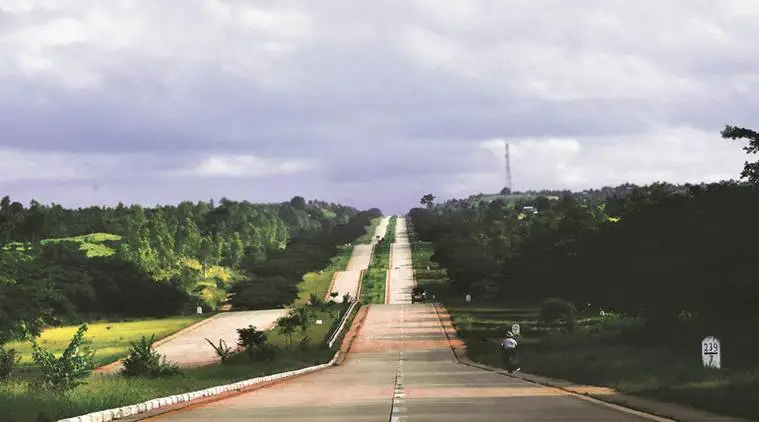 A portion of the ‘Trilateral Highway’ from Mandalay to Yangon, going through countryside that remains untouched by development. (Express photo by Neeraj Priyadarshi)
A portion of the ‘Trilateral Highway’ from Mandalay to Yangon, going through countryside that remains untouched by development. (Express photo by Neeraj Priyadarshi)
Sixteen years after India, Myanmar, Thailand agreed to build a 1,300-km highway, to bind the three countries together, and bring Delhi closer to ASEAN, two crossings were opened on August 8. The Indian Express travels down a road hiccuping its way through a country central to the region’s power games and churning with change.
The car is an old Japanese Nissan AD van, the driver is Tha Kwin, from Tamu, Myanmar, his fuel is paan, several rolled-up betel leaves in a plastic bag, hanging from the indicator lever. The aim is to cover 500 km, from Myanmar’s border with India at Moreh, to Mandalay in central Myanmar, the first leg of the ‘Trilateral Highway’.
This is the ambitious project that seeks to connect India with Myanmar and onwards to Thailand, which Delhi hopes will be its gateway to ASEAN. The first 160 km stretch is called the India-Myanmar Friendship Highway (IMFH).
The project of connecting three nations, which grew from small beginnings in 2002, is a work in progress. But India and Myanmar recently opened two land crossings to travellers with valid visas and passports, a significant baby step in this grand scheme for “free movement of people and goods” between India and South East Asia. One through Moreh in Manipur, opposite Tamu in Myanmar’s north-western Sagaing division, the other in Zokhawthar in Mizoram, opposite Rhikhawdar in Myanmar’s Chin state.
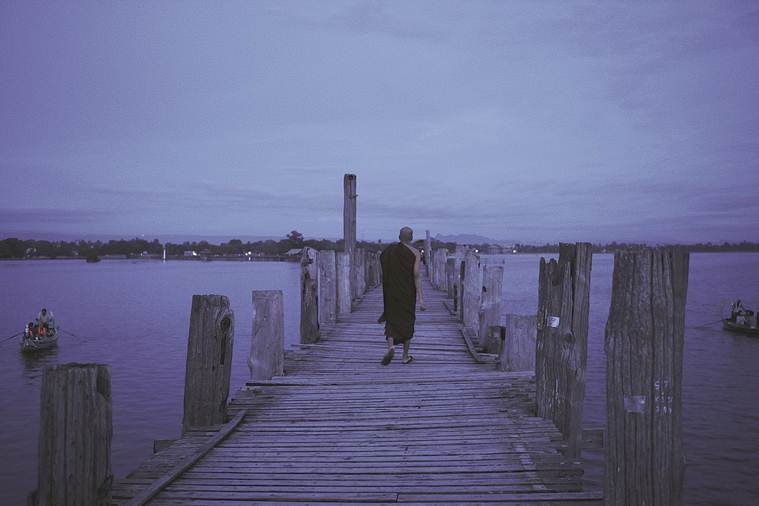 Over the Taungthaman lake near Amarapura city stands U Brien, the world’s oldest and longest wooden bridge. (Express photo by Neeraj Priyadarshi)
Over the Taungthaman lake near Amarapura city stands U Brien, the world’s oldest and longest wooden bridge. (Express photo by Neeraj Priyadarshi)
But because the three countries involved in the Trilateral Highway project are yet to agree on the movement of vehicles across their national borders, the autorickshaw from Moreh must stop at a Bailey bridge, a clattering, 100-m-long, World War II-era number over the Menal river. Across the bridge, on the other side, is Myanmar.

At the vast new Integrated Check Point on a slope overlooking the bridge, two immigration and two Customs personnel, the only occupants of this empty office, examine the documents. Clearly, those who planned this building, with a passenger terminal, parking bay, and an import warehouse, hope that one day it will be the centrepoint of a bustling entrepôt.
Not that Moreh, and Tamu, its opposite number in Myanmar, are not bustling already. Local people on both sides, and traders from as far away as Mandalay in Myanmar (468 km) and Imphal (110 km) and other parts of the Northeast have been trading with each other at this point for years. But the USD 50 million trade over this border is small change. The strategic objectives and the economic vision of India’s Look East, or Act East, policy aspire to something more ambitious.
Just as much as it is to China’s Belt and Road Initiative, Myanmar — ASEAN’s largest country by land area, among its least developed by economy — is central to this Indian plan. Reciprocally, India could be Myanmar’s, and ASEAN’s, gateway to South Asia.
The sentries at the Assam Rifles checkpost don’t know all the details yet. They note down everything from the passport, because “all movement has to be reported back to our officers” and it is a “militants ka area”.
 Click to enlarge.
Click to enlarge.At the bridge, a small yellow concrete slab announces the start of the India-Myanmar Friendship Highway. Some vehicles do cross the bridge. They have no number plates, a concession made for people who make a living from the Moreh-Tamu border trade.Like the red open pick-up van nosing into India with a load of watermelon; and the bright blue one that follows with onions and garlic. Betel nut and pulses are the two big items traded over this border, apart from “third country” goods — Chinese-made T-shirts, footwear, bags, and Thai thingummies.
Traders and shoppers also cross over from either side — the Myanmar women identifiable by the parasol made of parachute fabric fixed over their two-wheelers and the sandal paste on their faces.
At the opposite end of the bridge, after the Myanmar immigration officers pore over the documents, a car passing by offers a ride to Tamu, less than 2 km away, for Indian Rs 300.
Tha Lawin will charge Kyats 140,000 (Myanmar currency, pronounced Chhat) one way to Mandalay, or Rs 7,500 in Indian currency. An Indian with a rucksack full of currency notes in Namphalong, the market in Myanmar to which Indian traders flock from Moreh, changes Rs 5,000 for Kyat 100,000.
As he hands out a sheaf of new Kyat, the 20-something money changer says dourly that it would have been a better deal the previous day, when one rupee was Kyat 22.
At a shop in the same market, Kyat 5,000 fetches a SIM card, which includes Kyat 2,000 talk time and 1 GB data.
******
For an indicator of how much Myanmar has changed since 2012, when the then military rulers began taking the first hesitant steps towards a transition to democracy, look no further than the SIM card. For close to a good six decades before that, Myanmar was shut to the outside world, with the Tatmadaw or the military ruling with an iron grip, and China the main foreign presence.
Now the roads in the former capital Yangon are clogged with rush-hour traffic, and the cars are all modified Japanese Honda, Toyota or Suzuki, the last of which also has a local plant. Bigger vehicles are from Japan and Korea, two nations with a major presence in Myanmar. That is, other than China, which at $20 billion, remains the largest investor. India ,at under $1 billion, is the 11th biggest investor.
High-rise buildings in the downtown area tower over the older colonial-era buildings. There has been an explosion of shopping malls selling designer brands from Southeast Asia. The supermarkets are stocked with an array of foreign goods. Lotte, the South Korean hotel chain, has a shiny new property that has become a landmark in central Yangon. Lotteria, an East Asian fast food chain, has established itself in the cities. Grab, the South East Asian version of Uber, is all the rage among young commuters.
Photos | The Road to East: From India’s Moreh to Myanmar’s Mandalay
For all the interest in Myanmar, the country has still not been able to convince either its own people or its international interlocutors that Naypyidaw, the official capital since 2006, is a real city. Located 350 km north of Yangon, it remains the world’s emptiest capital, with 1 million people spread over an area of about 7,000 sq km — though the crowds at the Junction Centre mall give a momentary illusion of a packed city. Traffic is still light to non-existent on the roads, the smallest of which are eight-lane-wide. The largest span 20 lanes. Bureaucrats form the bulk of the residents; diplomats, politicians, and deal makers have got used to making day or overnight trips to this seat of power. On weekends, the city is a ghost town.
At the Ocean supermarket in the mall, crowds of families move from aisle to aisle gawking at the imported products, including Ponds and Sunsilk cosmetics from India.
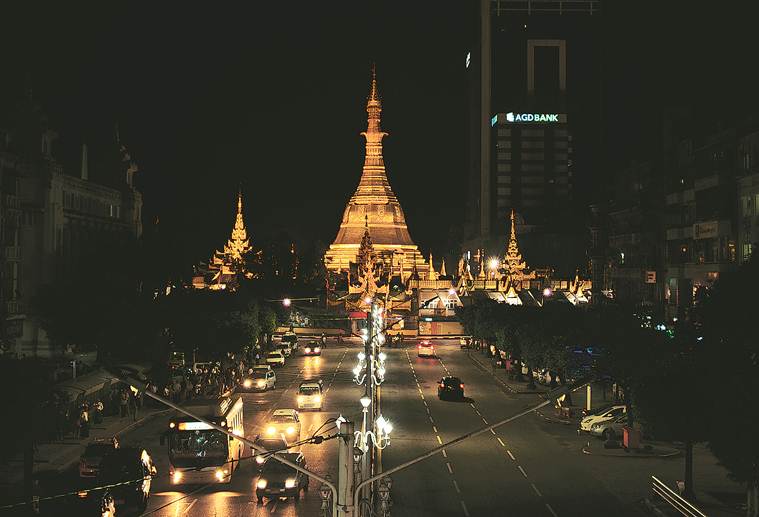 Yangon has rush-hour traffic, high-rise buildings, and malls stocked with foreign goods. (Express photo by Neeraj Priyadarshi)
Yangon has rush-hour traffic, high-rise buildings, and malls stocked with foreign goods. (Express photo by Neeraj Priyadarshi)
But it is the SIM card that provides a snapshot of how far Myanmar has come. Before 2012, a Myanmar Telecommunication SIM card cost upward of $1,000, going up to $3,000 once, perhaps more expensive than the country’s famed rubies. In 2012, news that SIM card prices would be slashed to about $300 made a huge splash. Today, four years after the sector opened up in 2014 to Ooredeo from Qatar and Norway’s Telenor, the price of a prepaid SIM has dropped to $1.
Last March, the Ministry of Transport and Communication said 46 million of the country’s 53 million population was accessing the Internet, most of them through their mobile phones, most of them through Facebook.
******
The rapid changes remain an urban phenomenon, with the countryside, where most of the poor live, virtually untouched for now. A joint estimate in December 2017 by the World Bank and Myanmar government put the number of poor nationally at 32 per cent, with 38.8 per cent of the people in rural areas poor compared to 14.5 per cent in cities.
On the India-Myanmar Friendship Highway, vast distances can go by without habitation. The area is as undeveloped as swathes of India’s Northeast. Giant rainforest trees join over a largely traffic-free highway like quiet guardians. Occasionally groups of houses appear, and at some spots, dhaba-like eateries, pit stops for those driving past. There are few hoardings, mainly of telecom firms.
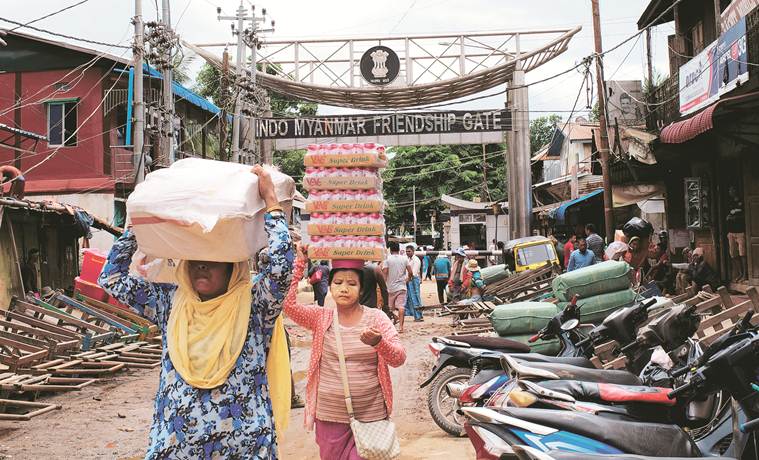 The Moreh border market is hoping for better days now. (Express photo by Neeraj Priyadarshi)
The Moreh border market is hoping for better days now. (Express photo by Neeraj Priyadarshi)
In a paddy field along the highway in Kale district of Myanmar’s Sagaing region, where a football game is in progress, dozens of men and boys from the nearby Chin Saing village are cheering for their team.
Kyaw Htay Naing, 21, says he is a Bollywood fan, and watches films on his mobile phone. “Three Idiots is my favourite film,” he says, speaking in halting English.
For Kyaw’s father, a goldsmith, the fact that his son can speak English is a big deal. But Kyaw, who is in sixth year of a mechanical engineering course at Kalay Technology University, is “unsure” of his future. “This country does not have jobs.”
In Kalemyo, the main town in Kale district, 10 hotels have come up in the past five years but there aren’t many visitors, says T Kapmung, manager of the 20-year-old Hotel Taungzalat, a throwback to the era when the junta ruled. The party of the military generals, Union Solidarity and Democratic Party (USDP), has an office next door.
“We don’t like the USDP,” says a guest at the hotel. “They ruined the country, and now they use religion to divide the people for their own benefit. However, the government under the National League for Democracy (NLD) is struggling to provide governance. The USDP is corrupt and bad, the NLD is inexperienced. Those are our two choices.”
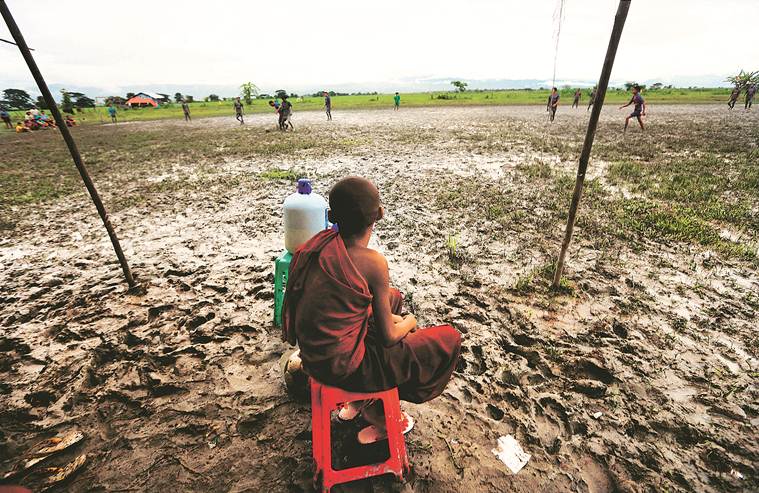 At a game of football in a paddy field in Kale district, where the overriding concern is jobs. (Express photo by Neeraj Priyadarshi)
At a game of football in a paddy field in Kale district, where the overriding concern is jobs. (Express photo by Neeraj Priyadarshi)
Outside a petrol station at Naypyidaw, stands a row of shiny BMWs waiting to be test-driven. A salary equivalent to between USD 150-200 is the typical middle-class monthly pay packet. This is what a college lecturer, or a mid-ranking bureaucrat, earns. So who is buying the BMWs?
“Cronies” is the single most recognised English word in Myanmar along with “lady”, which stands for Aung Sang Suu Kyi, Myanmar’s democracy icon, now State Counsellor. In the years of military rule, cronies was the term used to describe those who got lucrative contracts and made millions. Ask anyone in Myanmar if there are cronies today, and the answer is a guffaw. “Of course, cronies breed cronies,” says Tara Shankar, an Indian-origin trader in Mandalay.
******
The stretch from Mandalay to Yangon is the fastest in the entire Trilateral, the four-lane expressway helping cover the 625-km distance via Naypyidaw in about six hours. Along the way, transmission towers that will send electricity from China to Bangladesh through Myanmar keep company.
As for the rest of Trilateral Highway, a freight corridor is still a few years away. Right now, stretches of the road are more a biker’s adventure than a trucker’s workday. From Moreh to the border town of Mae Sot in Thailand, where the Trilateral ends, is roughly 1,300 km, just 100 km less than the distance between Delhi and Mumbai. A truck going down that stretch of the Golden Quadrilateral could cover the stretch in 24 hours. On the Trilateral now, it would take at least three, if not four, days.
At Yangon, 427 km from Mae Sot, the news on Facebook is that after a point called Thaton, there is flooding, and the road is not in good condition. Myanmar is to build a 70-km portion just after Thaton, from Ein Du to Kawkareik. Thailand, for its part, has built a 31-km section from Thin Gan Nyi Naung, close to its border, to Kawkareik.
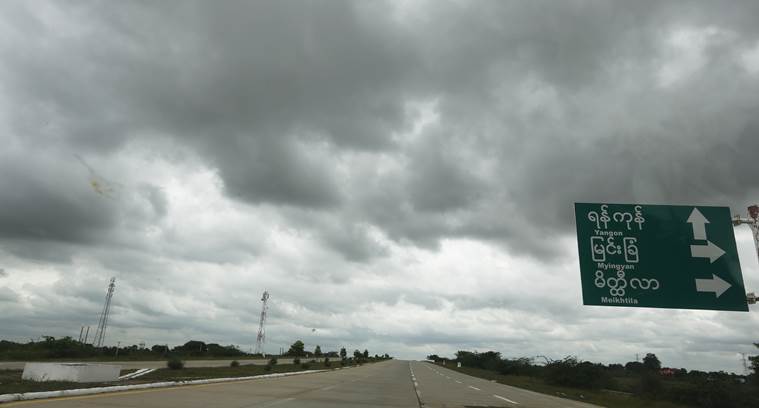 A stretch of the newly constructed India-Myanmar-Thailand Trilateral Highway. The 1980 Kms stretch is an intitiative by India as its ‘Look East Policy’ and is scheduled to be completed by 2021 aiming at boosting trade and commerce in the ASEAN free trade area. (Express Photo by Neeraj Priyadarshi)
A stretch of the newly constructed India-Myanmar-Thailand Trilateral Highway. The 1980 Kms stretch is an intitiative by India as its ‘Look East Policy’ and is scheduled to be completed by 2021 aiming at boosting trade and commerce in the ASEAN free trade area. (Express Photo by Neeraj Priyadarshi)
Starting at the bridge in Moreh, the IMFH goes from Tamu to Kyigone to Kalewa. A single-carriageway, it was first built in 2001 by the Border Roads Organisation (BRO) under a bilateral pact with Myanmar. The BRO maintained the road until 2009, when it was handed over to Myanmar.
“Very difficult,” says the otherwise silent Tha Lawin. Unilaterally, he has already taken a detour onto a road marked on maps as ‘Asian Highway 1’ to reach Kaleymyo.
At a lonely T-junction before Kaleymyo, where the AH1 meets the IMFH again, a commemoration plaque marks the 2002 visit to the spot by then foreign minister Jaswant Singh, to inaugurate work on the road.
The IMFH that Tha Lawin has left behind has 69 Bailey bridges en route, just like the one on the Moreh-Tamu border, all in various states of disrepair. Tha Lawin navigates the 10 or so bridges falling before the detour to AH1 charily.
After a standoff of a few years on whether the repair of the 1940s bridges was India’s responsibility or Myanmar’s, India agreed in 2016 to replace them with RCC structures, at a cost of USD 46 million. Work is yet to begin. Along with this, India also took up the task of repairing a hilly portion from Kalewa to Yargi, on the stretch to Monywa, at USD 184 million. Punj Llyod, the contractors, are expected to finish the work only by 2021.
Rain and the terrain are the two stated causes for the delay. The Myanmar monsoon stretches from May to October.
On the AH1, the 475-km distance to Mandalay is supposed to be a 12-hour ride, but with tea breaks in pouring rain, it takes 18. Tha Lawin favours a variety of Myanmar pop that are rip-offs of Western oldies, turning off the medley only when a massive bridge looms up suddenly. The towering Yadanabon bridge is the gateway to Mandalay, the last royal capital of Myanmar. Under it flows the Irrawaddy, a greyish shimmering sheet in that pre-dawn moment. Around it are glittering golden pagodas.
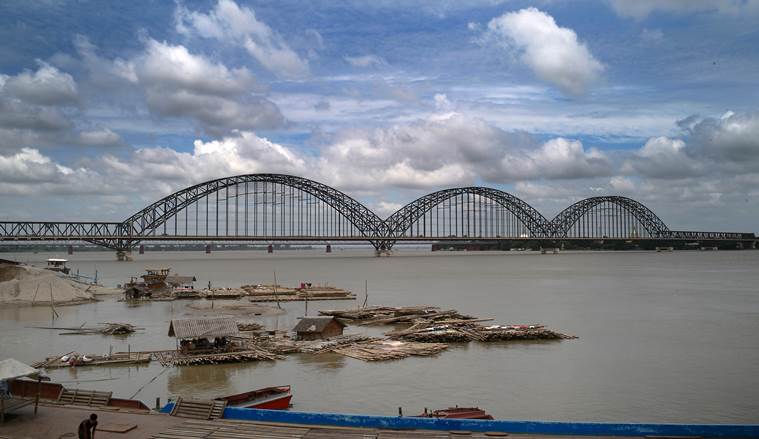 The Yadanabon bridge in Myanmar. (Express Photo by Neeraj Priyadarshi)
The Yadanabon bridge in Myanmar. (Express Photo by Neeraj Priyadarshi)
The bridge was built by China CAMC Engineering under a 2002 contract with Myanmar’s military government. Nearly 2-km long, it has four lanes.
Near the city of Amarapura, outside Mandalay, over the Taungthaman lake, stands U Brien, the world’s oldest and longest wooden bridge. Unmindful of the hundreds of tourists walking up down the teak wonder’s pedestrian walkway at sunset, monk
U Ott Tama contemplates the darkening skies from his perch on a wooden bench. “I come here every day from my monastery,” he says, pointing to one of the pagodas in the distance. “It is a meditation centre for a small group of monks.”
The military, he says, destroyed Myanmar. “Now it is better. The government is focusing on health and education.”
U Ott Tama says that throughout the independent history of Myanmar, monks and students have played an important role. Asked about the violence against the Rohingya, the monk says his English is not good enough for the right answer to that question. Getting up to return to his monastery, he only says: “Myanmar is right, and the world is wrong about what is happening in Rakhine.”
Around 160 km south of Mandalay on the expressway, the multicultural Meiktila, where Buddhists, Muslims, Hindus and Christians all live, is far from Rakhine. But in 2013, in the expanding circles of communalism after the first incidents of anti-Rohingya violence in 2012, a fight between a Muslim shop owner and a Buddhist family blew up into serious riots in which 40 people were killed and thousands became homeless.
Since then, seven out of 14 mosques in the city have been shut down. Three madrasas and an Arabic university are also shut. At two of the closed mosques, the gates are blocked with massive trucks. “It’s only a parking spot now that the mosque is not in use,” says Suleiman, who was only recently released after a five-year prison term, on charges of being part of a mob that killed a monk. Suleiman has just returned home from the Eid sacrifice in a village outside Meiktila. It is banned in the town now.
His friend says Meiktila is still recovering from the events of 2013. “Hatemongers are still targeting this place, hoping to create some problem again,” he says, but explains that more sensible residents are involved in inter-faith dialogue to ensure that Meiktila remains peaceful.
The town is also famous for the Buddhist monk U Vithuddha, who opened his monastery to about 800 Muslims fleeing murderous mobs. Vithuddha is away, but other monks point to the raised assembly hall in the monastery where Muslim families stayed to escape the violence.
******
Back in Moreh, residents have a question. How would the Trilateral Highway work without industrial development in Manipur, asks 72-year-old Guruswamy, whose parents came to India from the then Burma in 1962. Even now, Guruswamy points out, the big traders from Kolkata, who at one time frequented Moreh-Tamu, are routing their imports and exports to Yangon through Kolkata Port because it is easier and quicker than transporting stuff from the Northeast.
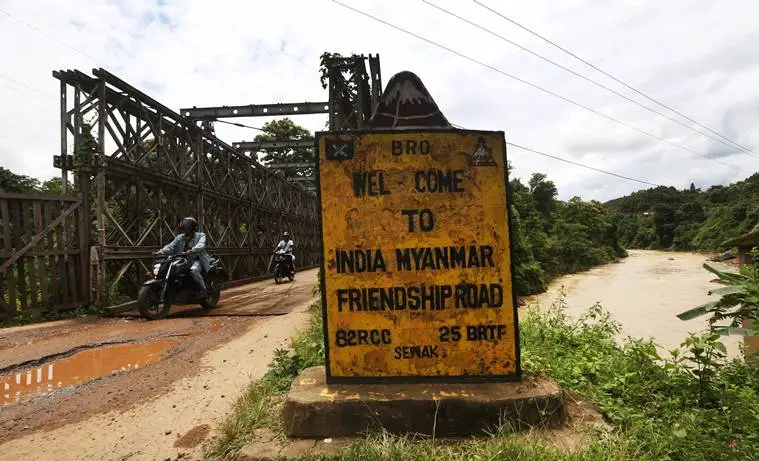 The Indo-Myanmar friendship bridge at Moreh joining Tamu in Myanmar, the first of 69 bridges on the newly constructed India -Myanmar-Thailand Trilateral Highway. (Express Photo by Neeraj Priyadarshi)
The Indo-Myanmar friendship bridge at Moreh joining Tamu in Myanmar, the first of 69 bridges on the newly constructed India -Myanmar-Thailand Trilateral Highway. (Express Photo by Neeraj Priyadarshi)
A few years ago, the Moreh-Tamu land crossing, and the one in Mizoram, were recognised as land crossings for country trade between India and Myanmar. But the trade over this border has remained small. Earlier this year, India hiked duties on betel nut and moong dal, Myanmar’s main exports to India, from about 5 per cent to 40 per cent. “That has finished the big trade through this border,” he says.
Moreh residents also compare themselves unfavourably to the Chinese border town of Ruili in Yunan, opposite Muse on Myanmar’s eastern border. The word in Moreh is that China has pumped in much money into Ruili to make it a modern city, attractive to traders from Myanmar. Cross-border trade is flourishing there, Beijing’s gateway to the Bay of Bengal.
This border point where China meets Myanmar is that bustling entrepôt that Moreh aspires to become. Mandalay to Muse is a 453-km journey, and though it takes 10 hours, it is one of the busiest trade routes in Myanmar. A large portion of China’s trade with Myanmar, which crossed $ 8 billion last financial year, is through Muse. In Moreh, though, residents await 3G with enough bars for uninterrupted Internet connectivity.
Trade numbers
India-myanmar trade
# India is Myanmar’s fifth largest trading partner
# Bilateral trade amounting to USD 1,605.84 million in 2017-18. In comparison, in 2015, Myanmar’s two-way trade with China stood at $9.6 billion, and with Thailand, it was $5.7 billion
Border trade is around $50 million a year
# Myanmar is the second-largest supplier of beans and pulses to India ($809 million, 2016-17), apart from a big exporter of timber and wood products
# India’s export basket to Myanmar includes pharma products, steel & iron products, electrical machinery, mineral oil, vehicles other than railway or tramway rolling stock
# India is currently the 11th largest investor in Myanmar. FDI from India to Myanmar amounted to USD 763 million as of July 2018
Sources: Department of Commerce, Ministry of External Affairs, FICCI, ORF, Directorate of Investment and Company Administration, Myanmar
India-Thailand trade
# In ASEAN, Thailand is India’s 4th largest trading partner after Singapore, Indonesia, Malaysia
# Bilateral trade is expected to rise from $8.55 billion in 2016-17 to $16 billion by 2021
# Machinery and vehicles comprise the top 10 traded items between India and Thailand
Apr 19: Latest News
- 01
- 02
- 03
- 04
- 05






































